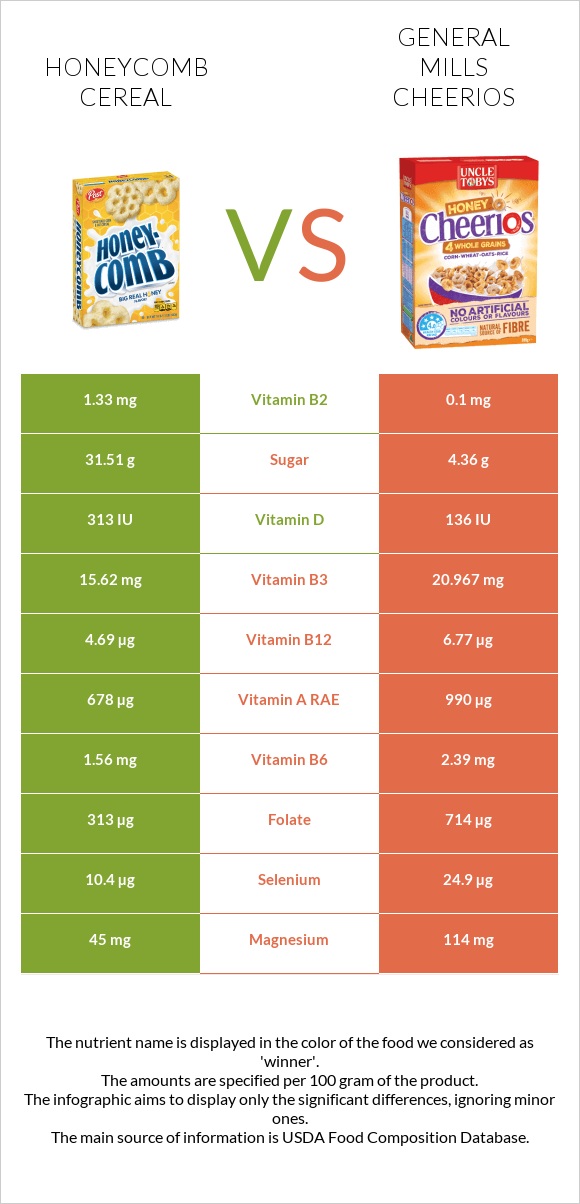Honeycomb Cereal vs. General Mills Cheerios — In-Depth Nutrition Comparison
Compare
How are honeycomb Cereal and general Mills Cheerios different?
- Honeycomb Cereal is higher in vitamin B2 and vitamin D; however, general Mills Cheerios are richer in iron, zinc, folate, vitamin B12, vitamin B6, phosphorus, calcium, and vitamin B3.
- Daily need coverage for iron for general Mills Cheerios is 309% higher.
- Honeycomb Cereal contains 13 times more vitamin B2 than general Mills Cheerios. While honeycomb Cereal contains 1.33mg of vitamin B2, general Mills Cheerios contain only 0.1mg.
Cereals ready-to-eat, POST, Honeycomb Cereal and Cereals ready-to-eat, GENERAL MILLS, CHEERIOS are the varieties used in this article.
Infographic

Infographic link
Mineral Comparison
Mineral comparison score is based on the number of minerals by which one or the other food is richer. The "coverage" charts below show how much of the daily needs can be covered by 300 grams of the food.
| Contains more MagnesiumMagnesium | +153.3% |
| Contains more CalciumCalcium | +3545.5% |
| Contains more PotassiumPotassium | +351.4% |
| Contains more IronIron | +293% |
| Contains more CopperCopper | +196.2% |
| Contains more ZincZinc | +256.7% |
| Contains more PhosphorusPhosphorus | +264.4% |
| Contains less SodiumSodium | -10.1% |
| Contains more SeleniumSelenium | +139.4% |
Vitamin Comparison
Vitamin comparison score is based on the number of vitamins by which one or the other food is richer. The "coverage" charts below show how much of the daily needs can be covered by 300 grams of the food.
| Contains more Vitamin DVitamin D | +129.4% |
| Contains more Vitamin B2Vitamin B2 | +1230% |
| Contains more Vitamin CVitamin C | +∞% |
| Contains more Vitamin AVitamin A | +46% |
| Contains more Vitamin EVitamin E | +282.4% |
| Contains more Vitamin B1Vitamin B1 | +13.4% |
| Contains more Vitamin B3Vitamin B3 | +34.2% |
| Contains more Vitamin B6Vitamin B6 | +53.2% |
| Contains more Vitamin B12Vitamin B12 | +44.3% |
| Contains more Vitamin KVitamin K | +200% |
| Contains more FolateFolate | +128.1% |
All nutrients comparison - raw data values
| Nutrient |  |
 |
DV% diff. |
| Iron | 8.44mg | 33.17mg | 309% |
| Manganese | 3.547mg | 154% | |
| Zinc | 4.69mg | 16.73mg | 109% |
| Folate | 313µg | 714µg | 100% |
| Vitamin B2 | 1.33mg | 0.1mg | 95% |
| Vitamin B12 | 4.69µg | 6.77µg | 87% |
| Vitamin B6 | 1.56mg | 2.39mg | 64% |
| Phosphorus | 132mg | 481mg | 50% |
| Calcium | 11mg | 401mg | 39% |
| Vitamin A | 678µg | 990µg | 35% |
| Vitamin B3 | 15.62mg | 20.967mg | 33% |
| Copper | 0.13mg | 0.385mg | 28% |
| Selenium | 10.4µg | 24.9µg | 26% |
| Fiber | 3.2g | 9.4g | 25% |
| Vitamin C | 0mg | 21.6mg | 24% |
| Starch | 57.37g | 24% | |
| Vitamin D | 313 IU | 136 IU | 22% |
| Vitamin D | 7.8µg | 3.4µg | 22% |
| Vitamin B5 | 1.073mg | 21% | |
| Magnesium | 45mg | 114mg | 16% |
| Potassium | 142mg | 641mg | 15% |
| Vitamin B1 | 1.17mg | 1.327mg | 13% |
| Protein | 6.01g | 12.09g | 12% |
| Polyunsaturated fat | 0.91g | 2.432g | 10% |
| Fats | 2.93g | 6.73g | 6% |
| Carbs | 86.63g | 73.23g | 4% |
| Monounsaturated fat | 0.6g | 2.376g | 4% |
| Vitamin E | 0.17mg | 0.65mg | 3% |
| Choline | 8.6mg | 26.2mg | 3% |
| Sodium | 553mg | 497mg | 2% |
| Calories | 394kcal | 376kcal | 1% |
| Vitamin K | 0.6µg | 1.8µg | 1% |
| Saturated fat | 1.29g | 1.5g | 1% |
| Net carbs | 83.43g | 63.83g | N/A |
| Sugar | 31.51g | 4.36g | N/A |
| Trans fat | 0.01g | 0.02g | N/A |
| Tryptophan | 0.167mg | 0% | |
| Threonine | 0.418mg | 0% | |
| Isoleucine | 0.429mg | 0% | |
| Leucine | 0.91mg | 0% | |
| Lysine | 0.366mg | 0% | |
| Methionine | 0.178mg | 0% | |
| Phenylalanine | 0.628mg | 0% | |
| Valine | 0.586mg | 0% | |
| Histidine | 0.261mg | 0% | |
| Fructose | 0.09g | 0% | |
| Omega-3 - ALA | 0.068g | N/A | |
| Omega-6 - Gamma-linoleic acid | 0.001g | N/A | |
| Omega-6 - Eicosadienoic acid | 0.001g | N/A | |
| Omega-6 - Linoleic acid | 2.344g | N/A |
Macronutrient Comparison
Macronutrient breakdown side-by-side comparison
Protein:
6.01 g
Fats:
2.93 g
Carbs:
86.63 g
Water:
1.5 g
Other:
2.93 g
Protein:
12.09 g
Fats:
6.73 g
Carbs:
73.23 g
Water:
5.13 g
Other:
2.82 g
| Contains more CarbsCarbs | +18.3% |
| Contains more ProteinProtein | +101.2% |
| Contains more FatsFats | +129.7% |
| Contains more WaterWater | +242% |
~equal in
Other
~2.82g
Fat Type Comparison
Fat type breakdown side-by-side comparison
Saturated fat:
Sat. Fat
1.29 g
Monounsaturated fat:
Mono. Fat
0.6 g
Polyunsaturated fat:
Poly. Fat
0.91 g
Saturated fat:
Sat. Fat
1.5 g
Monounsaturated fat:
Mono. Fat
2.376 g
Polyunsaturated fat:
Poly. Fat
2.432 g
| Contains less Sat. FatSaturated fat | -14% |
| Contains more Mono. FatMonounsaturated fat | +296% |
| Contains more Poly. FatPolyunsaturated fat | +167.3% |





